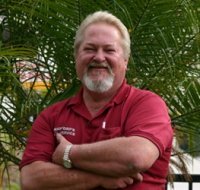Categorized RV Dictionary
In this RV dictionary we've compiled a list of some of the most commonn RV expressions, jargon, tools, manufacturers, and other RV related terms. We hope it will help you both navigate and contextualize the rest of the site. Learn fast, learn smart, save money!
Search by Category
| Awnings | Batteries | Water Systems |
| Manufacturers | Electrical | Slang, Abrvs, & More |
RV Awnings: (Learn more...)
Awning Arms: Located on both sides of your RV awning, the awning arms go from the awning rail to the roller tube, and from the roller tube to either the ground or the brackets on the side of your RV to help support and keep tension on your awning.
Awning rail: The rail which holds the awning fabric to the top side of your RV.
Awning Rod/Wand: A long skinny metal pole with a bent hook on one end used to open and close your RV awning.
Rafter Knobs: Typically black, these knobs are found on RV awnings and are used to tighten and hold your awning arms into place.
Roller Tube: Found on a RV awning, a roller tube is the long cylindrical tube connected to the awning fabric. It contains the powerful spring which allows your awning to roll back to the closed position against the side of your RV with little effort.
Support Arms: The awning arms can be broken down into two sections, one of which is the support arms. This is the part of the awning arms that go from the roller tube to the ground or connect to the brackets located on the side of your RV.
Tension Arms: The awning arms can be broken down into two sections, one of which is the tension arms. The tension arms go from the awning rail to the roller tube and hold your awning tight and in place. They keep tension on the fabric.
RV Batteries: (Learn more...)
Converter: A Converter changes or converts 120 volt AC power to 12 Volt DC power.
House Batteries: The batteries that supply power to the functions of your RV that you would typically have in your house. This is pretty much everything but your engine.
Inverter: An Inverter changes or inverts 12 volt DC power to 120 volt AC power.
Parallax: A manufacturer of RV power products most commonly known for their converters.
Umbilical Cord: A wire which connects you travel trailer to your tow vehicle during transport. The umbilical cord charges the batteries on trailer with DC power. It also operates your trailers brake and turning signal lights.
RV Electrical Systems: (Learn more...)
15 and 20 amp service: This is the power available from a standard household outlet or garage. To use 15 and 20 amp service you will need an adapter and will be very limited to which appliances you can use.
30 amp service: Found in most all RV parks and is the standard on most RVs and trailers. 30 amp service is the typical amount of power an RV can sustain. With 30 amp service you can run one air conditioner and a few additional appliances at the same time. You know you have 30 amp service when you have a large 3 prong plug.
50 amp service: Becoming more popular, 50 amp service is the most powerful electrical capability that a RV can handle. 50 amp capabilities are most often found on newer and higher end RVs. With 50 amp service you can run both air conditioners as well as other appliances simultaneously. You know you have 50 amp service when you have a large 4prong plug.
Volt meter: A small tool that plugs into any outlet in an RV to show when an RV is receiving safe levels of power to operate appliances without damage.
RV Water Systems:
Anode rod: An anode rod is used to prevent corrosion in a water heater. It attracts elements in the water so that your water heater doesn't rust and leak. It should be replaced annually.
Black water: The waste from your toilet
Black water tank: The tank that holds waste from the toilet
Dump Station: A place to empty your black and grey water tanks. A Dump station normally has a water supply to refill your fresh water tank as well. Almost all Dump stations are free, but some charge a small fee. Dump stations can be found in campgrounds, rest areas, and occasionally in some gas stations.
Fresh Water Tank: The tank that holds the water you use for drinking, cooking, and bathing.
Grey Water: The waste water from your sinks and your shower/bathtub.
Grey Water Tank: This tank holds used water from your kitchen and bathroom sinks along with your shower/bathtub.
RV Manufacturers:
A&E: A major manufacturer of RV awnings.
Atwood: A manufacturer in RV parts including Water Heaters, Heating systems, and RV cooking appliances.
Dometic: A manufacturer most commonly known for its RV refrigerators. They also supply RV Awnings, AC/heat pump systems, and toilets.
HWH: A RV manufacturer that specializes in RV Leveling & Room Extension Systems (Slide-outs)
Norcold: A subsidiary of the manufacturer Thetford which specializes in producing RV refrigerators.
Parallax: A manufacturer of RV power products most commonly known for their converters.
Suburban: A manufacturer in water heaters, furnaces, and cooking appliances.
Thetford: A manufacturer known for its production of toilets
RV Slang, Abbreviations, and More:
Boondocking: Also known as dry camping, boondocking is camping with no electrical hook ups or outside water supply.
Camper Van: Another name for a Class B RV, A camper Van is an RV and Van combined. A Camper Van looks more like a van from the outside, but still includes most the living amenities found in a full sized RV.
Class A Motorhome: An RV that is built on a motorized chassis. Class A motorhomes are the most popular type of RV. In other words it is the motor home that looks like a rectangular box. They are also the longest of the three classes ranging 24 to 40 feet in length.
Class B Motorhome: An RV and Van combined. Sometimes called a Camper van, a Class B RV looks more like a van from the outside, but still includes most the living amenities found in a full sized RV. Class B Motorhomes are the shortest of the three classes ranging from 16 to 21 feet in length.
Class C Motorhome: An RV built on a truck chassis with the cab section attached. In other words it is the motor home with the overhang going above the driving area. Class C Motor homes are about 16 to 32 feet in length.
Cooling unit: The main cooling component in any standard RV Refrigerator. It is found on the back of your Refrigerator. Unlike refrigerators found in a house, A RV Refrigerator uses an ammonia absorption cooling system because of the unique forces put on it while driving.
Dry camping: Also known as boondocking, dry camping is camping with no electrical hook ups or outside water supply.
Dry Weight: Dry Weight is the weight of an RV including only standard equipment. This does not include fuel, water, waste, cargo, passengers, or optional equipment.
EPDM roofing: EPDM (ethylene propylene diene terpolymer) roofing is the rubber roofing material found on the majority of RVs today. (Learn more...)
GTW: The GTW (Gross Trailer Weight) is the same as Gross Vehicle Weight (GVW) but refers to a trailer instead of an RV. It is the total weight of the trailer when it is fully loaded with luggage, passengers, and vehicle systems which include, water, waste and fuel. The GTW is used to restrict the maximum amount of total weight of a trailer.
GVW: The GVW (Gross Vehicle Weight) is the total weight of the vehicle when it is fully loaded with luggage, passengers, and vehicle systems which include, water, waste and fuel.
GVWR: The GVWR (Gross Vehicle Weight Rating) is used to restrict the maximum total weight of an RV.
Lav: Slang for bathroom, short for lavatory.
NCC: The NCC (Net Carrying Capacity) is the maximum weight of the luggage you carry in your RV. This is different from GVW (Gross vehicle weight) in that it does not include the weight of passengers or your vehicle systems (water, waste and fuel.)
PDI: A PDI (Pre-Delivery inspection) is the necessary inspection performed to all RV's after purchased but before they are to be delivered to their new owner.
Pilot Light: A small flame that burns continuously in your appliances that use propane gas, such as your refrigerator or stove. Once your pilot light is lit, these appliances can run continuously without the flame needing to be re-lit.
Self Contained: Being self contained is operating with no hookups. Most larger RVs can run self-contained for up to 7 days. If you have kids or a smaller RV you can the ability to be self contained for as little as 2 days.
Self-leveling sealer: A sealer commonly used in repairing cracks in an RVs roof. It is applied using a calking gun, and as the name implies, it self-levels, so there is no further work to be done after it is applied.
Slide-Out: A part of the motorhome that can expand the square footage, increasing the size and living space of the motorhome.
Wide-Body: An RV having a width greater than 96 inches or 8 feet. A wide-body is typically either 100 or 102 inches in width.
UVW: Also known as Dry Weight, the UVW (Unloaded Vehicle Weight) is the weight of the RV without water, fuel, waste, supplies and passengers, or optional equipment.
Are there more RV facts you would like to know about? Contact us and let us know!
Enjoy this page? Please help us pay it forward to others who would find it valuable by Liking, Sharing, Tweeting, Stumbling, and/or Voting below.
Have a question about this topic?
Have a question about your RV? Chat with an expert one-on-one now.*
*Chat provided by JustAnswer.com, a third party not affiliated with MSRVR
Kind Words From Our Visitors

Hi, I'm Robbie. Welcome to Money-Saving-RV-Repair.com!
Like the name implies, this site is all about helping you save money while keeping your RV in tip-top shape--and that is all about you having the knowledge to do so.
I've been a technician in the RV industry for 30 years, operating out of San Diego, California. And let me tell you, I love my job.
But I also love empowering RVers with the knowledge they need to make the right decision on repairs, or to make the fix themselves--and that, my friend, is the reason for this website. I hope you enjoy.
Or, learn more about me, my RV service practice, & this website here.


